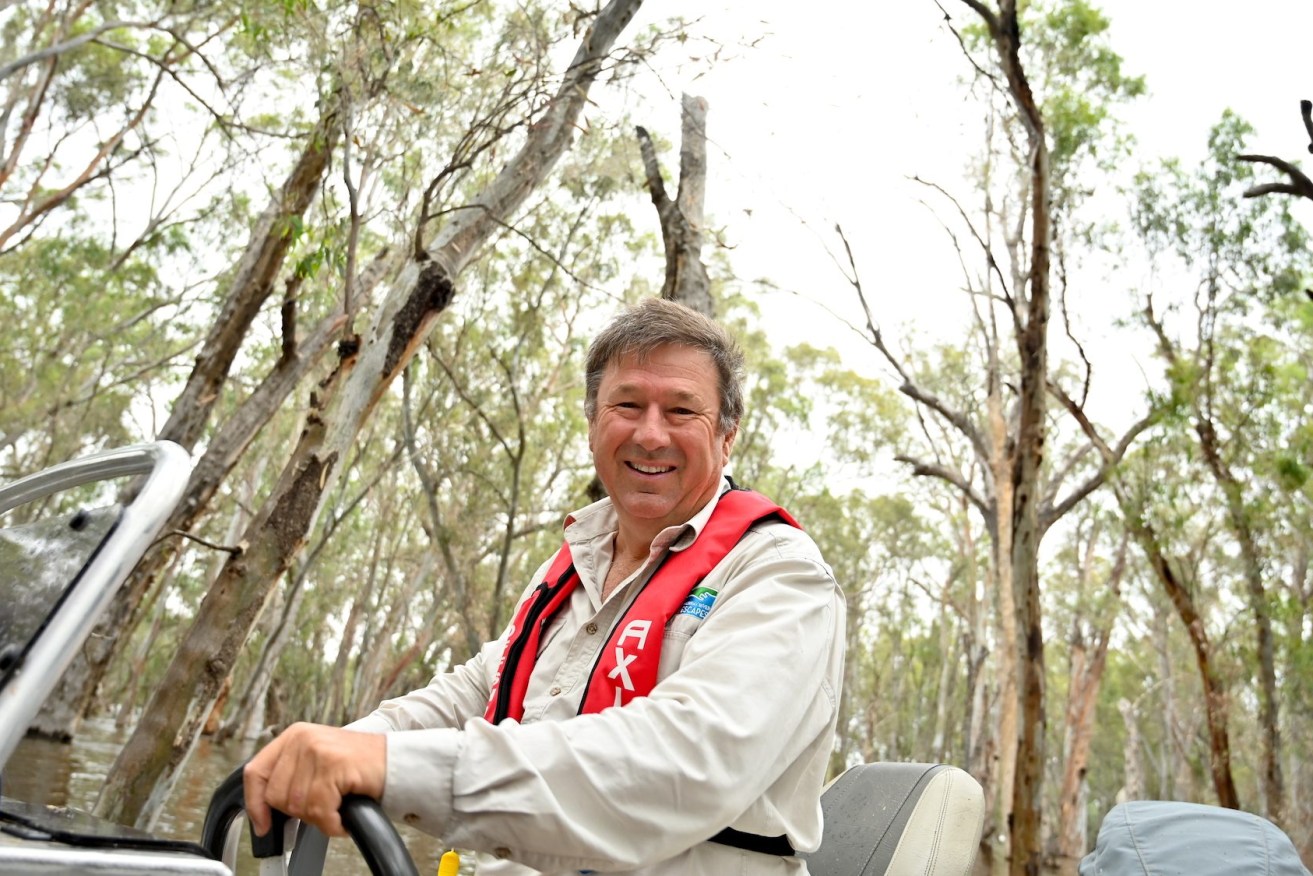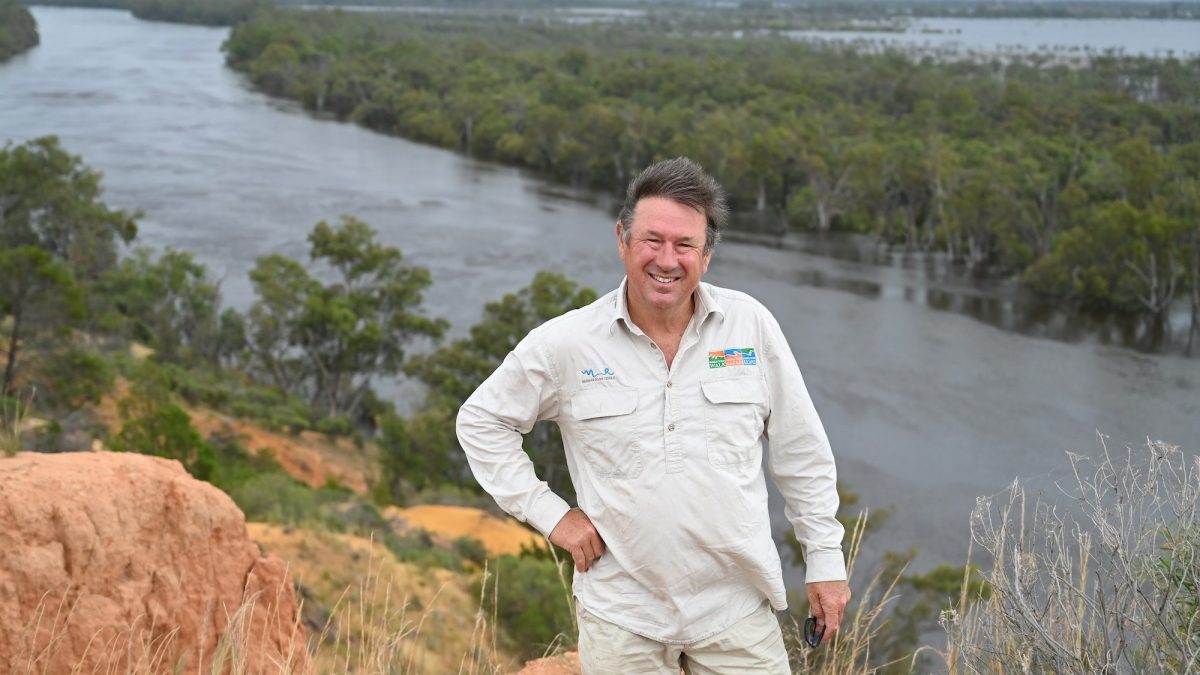Flooding River Murray’s big environmental boost
Tony Sharley points toward three river red gums he calls The Generals, the 600-year-old trees standing at attention as Captain Sturt traversed the River Murray and now getting their first decent drink in nearly 50 years.


Tony Sharley amongst river redgums on the flooded Murray at Murtho. Photo: Belinda Willis
Their branches will soon sport a profusion of light, green growth as the flooding waters upstream of the Murray Mouth at Murtho begin to recede, delivering the waterway its greatest environmental gift for decades.
“Red gums and the black box trees higher up are the signature of previous floods because that’s where they germinated, we have trees here that are 1000 years old,” says Sharley, whose Murray River Trails tourism business is inducted in the SA Tourism Industry Council’s Hall of Fame.
“They hold so much history, there are canoe scars from indigenous people in the red gums, shield scars in the box trees.”
While the flood water is causing pain to river communities, shack and home owners, farmers, business and tourism operators like Sharley, the environmental scientist is fascinated by the ecological story that is rapidly unfolding in its wake.
Water filling ancient floodplains near Renmark is supercharging the river system with zooplankton and phytoplankton, while flying insects and birds abound.
All around the Riverland from Renmark to Moorook, locals are reporting a surge in yabby numbers, with frog numbers expected to rise and undergrowth to regenerate.
Black swans are thriving in the Riverland on Yatco Lagoon near Moorook and Chowilla reserve, recognised as a wetlands of importance and one of the six The Living Murray icon sites in the Murray-Darling Basin.
There are sacred and straw-necked ibises, and the grey teal ducks “are in hollows everywhere breeding, everywhere we are seeing little clutches of ducklings”.
“We’re really excited to see spoonbills breeding, there are Royal Spoonbill and Yellowbilled Spoonbill,” Sharley says.
“Sacred kingfisher are appearing everywhere, they are mini kookaburras, and whistling kites, there’s just so much food for them in the water, they can grab a duckling or grab a fish.”
Sharley admits the current flood water is playing havoc with his business. A new eco houseboat was launched by Tourism Minister Zoe Bettison in June but is now empty, tethered safely in Renmark but bringing in no revenue.
Nor are there tours or leasing of their other houseboat, with Sharley looking to access State Government relief funding for businesses being hit hard all along the river.
“We called the new houseboat ‘High River’. People have said: ‘why did you call it High River and we say aren’t you glad we didn’t call it Ark,” he says with a laugh.
While the rare flood event is not helping Sharley’s business, he tries to focus on the positive ecological impacts for the mighty Murray.
This pulse of water is cleansing salinity from its path and there are hopes it is taking weeds down the system from plains once overgrazed by livestock, offering a chance to regenerate.
Fish too are breeding. The dreaded carp will benefit first as the dark water takes too much oxygen for the iconic Murray Cod, but as leaf litter is washed away it’s hoped they too will recover.
Sharley hopes the native fish that grow large enough to feed on the carp will, with luck, help counterbalance the pest numbers throughout the waterway.
While holidaymakers near the Murray Mouth may worry about the dark water spilling into the ocean as the river purges decades of leaf litter and salt, he says the nutrients will in turn help sea life.
“It will build another food chain and the King George Whiting, the Mulloway, will all benefit,” he says.

Tony Sharley at Murtho. Photo: Belinda Willis
Sharley knows there will be pain with the cleanup and that the high waters will lead to some suggesting hard work on returning environmental flows to the Murray should now be abandoned, but he warns they should not lose focus.
This high water, Sharley says, is many decades overdue.
The river system has been holding on by a thread as dams, irrigators, locks and changed development have left its fragile ecosystem including those black box, higher on the flood plains, struggling to survive without a drink for decades.
“Ultimately, it’s about protecting the gene pool, keeping the system alive in the dry years and those dry years are getting drier and drier with the amount of irrigation taking water out of the system,” he says, adding that it is important to visit to build a connection.
“It’s peaceful when you are down on the river,” he says, “and this is an ephemeral landscape, it simply means it comes and goes, it rises and floods and falls and dries.
“What we are seeing now is extremes in that range, it is filling every creek bed, every floodplain, the river has become connected to everything, it’s flowing through the forests, through the woodlands and the old river channels.”




